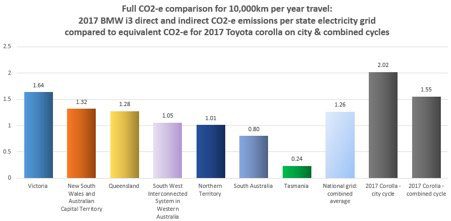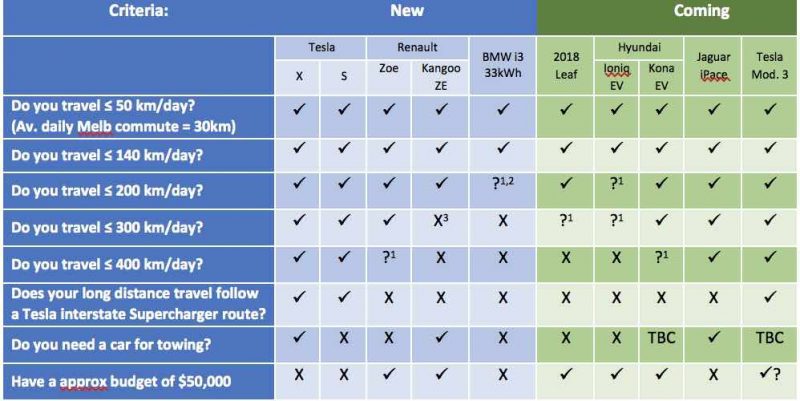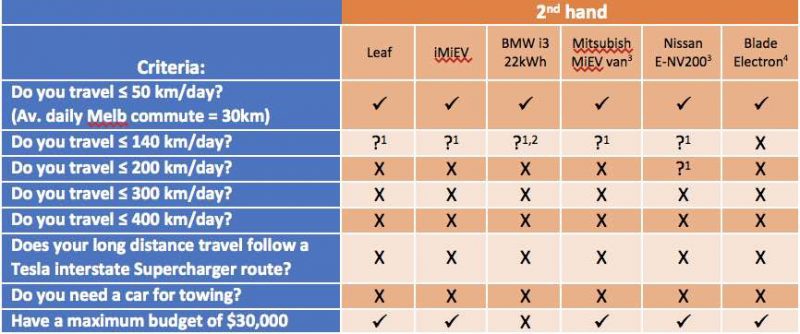It’s six months since I first wrote an article like this – and with the many exciting changes that have been happening in the Australian market, it seems an ideal time to revisit it.
A selection of new 300 – 500km range BEVs (Battery Electric Vehicles) are now finally trickling into Australian showrooms (See table 1).
We now have two setting the new price point of ‘around $50,000’, and three more will join them in the next few months. Tesla also now have a serious competitor to the Model X (and indirectly the S) with the Jaguar I-Pace.
Additionally, there are several recently superseded models being brought in as ‘grey imports’ to meet the frustrated demand for affordable EVs now.
So has the landscape changed enough to offer an EV that meets your budget or driving requirements? And does changing to an EV still offer other benefits to you and the environment?
(You can find out more at our section of FAQs and Readers’ Questions!)
What EV choice is there (or coming soon) for Australia?
Notes to table 1:
# Battery electric vehicles only listed. Not including Plug-in hybrids (PHEVs).
* Yet to be rated on Australian test cycle
# WLTP = new ‘Worldwide Harmonised Light-duty Vehicle Test Procedure’ (Closer to US EPA results)
Why buy an EV?
So yes, we do now have some EV choice in Australia, and it is about to grow a whole lot more in the latter part of this year – but why buy an EV at all given they are still more expensive than an equivalent petrol or diesel car?
Well, there are lots of reasons!
First of all they are cheaper to own and run. EV service costs are reduced as they don’t need engine oil, spark plug, filter and timing belt changes like an internal combustion engine (ICE) car.
EVs also have reduced brake wear as a lot of the vehicle’s braking effort is returned to the battery instead of heating (and wearing out) brake parts. Servicing an EV merely involves regular checks of the vehicle and its safety systems with very little needed in the way of ‘consumables’.
In addition, the fuel costs are considerably less, although rising electricity prices are eroding that a bit – unless that is you have excess solar capacity and can charge your BEV during that day: in that case your EV ‘fuel’ costs are virtually nil.
Assuming you do use the grid to charge your EV, and do it overnight using an ‘off-peak’ tariff: the following example will demonstrate the running cost savings on offer with a BEV:
Data choices:
Vehicle:Renault Zoe EV (quoted as using 133Wh/km)
Annual travel distance:10,000km/yr
Off-peak electricity tariff:25c/kWh:
Calculations:
EV: at 133Wh/km & 25c/kW = $332.50
ICE: at 8L/100km & 1.50/L (premium fuel) = $1200
Fuel saving: $1200 – $332.50 = $867.50
PLUS: Service savings: estimate $250/yr
Total saving (approx.): $1100/yr
Secondly, you get the following environmental benefits over ICE vehicles (and especially diesel ICEs). These include:
- No air pollution from the tailpipe;
- Reduced overall CO2-e. (Using the Carbon Accounting methodology and data as published by the Federal Government’s Department of the Environment and Energy. See graph 1);
- No longer being tied to using fossil fuels, so you can go further in replacing coal and gas fired generation with your own solar or subscribing to the greener wind, solar and hydro offered by the utilities;
- Reduction in waste such as coolants, oils, brake pads, spark plugs, air filters and the like.
Graph 1:

So when should you consider changing to a BEV?
EVs do not yet cover all the range of size, cargo and towing options available as ICEs.
However the choice is growing, as well as a selection of second-hand van and Nissan Leaf options becoming available with the importing of good second-hand examples from Japan. (NB: 2013 – 2017 Nissan Leafs are available through that business. Only 2011 & 2012 Nissan Leafs were officially brought in by Nissan for the Australian market).
As a result, I have now expanded the original table two showing the features of new EVs, as well as splitting off the expanded set of second-hand BEVs into their own table. Between them, they should assist you in deciding if it is worth making the change to a BEV now based on a selection of distance, route and cargo/towing options.
By the way, if no BEV yet suits your needs – you may not have long to wait. Overseas the range is expanding at a rapid rate as well as the announcements of new models to come.
On top of this: a number of economic forecasters have predicted the ‘price parity’ point for BEVs and their equivalent ICE vehicles to be somewhere around 2024 to 2028.
Table 2: Selection criteria applied to new BEVs on or soon to come to Australian market:
Notes to table 2:
1: Can make these ranges if topping up during day or use DC fast-charge option (or 3 phase AC charge for Zoe)
2: No DC fast-charge (or 3 phase AC charge) for pre-2018 BMW i3. 2018 i3 has both.
3: Kangoo ZE has neither fast-charge DC nor 3 phase AC options
Table 3: Selection criteria applied to currently available second-hand BEVs on Australian market:
Notes to table 3:
- Can make these ranges if topping up during day or use DC fast-charge option.
- No DC fast-charge (or 3 phase AC charge) for pre-2018 BMW i3. Note: some may have CCS1 DC port, but this needs to be changed to CCS2 to be useful (easy, but could be costly).
- Second-hand Japanese MiEV van and E-NV200 vans both now being imported by a vehicle business in Qld.
- Blade Electrons were a converted Hyundai Getz, done by a business in Castlemaine Victoria. Whilst cheap EV motoring, they are prone to failure and hard to repair. Best avoided unless you have good DIY EV skills!

Bryce Gaton is an expert on electric vehicles and contributor for The Driven and Renew Economy. He has been working in the EV sector since 2008 and is currently working as EV electrical safety trainer/supervisor for the University of Melbourne. He also provides support for the EV Transition to business, government and the public through his EV Transition consultancy EVchoice.





